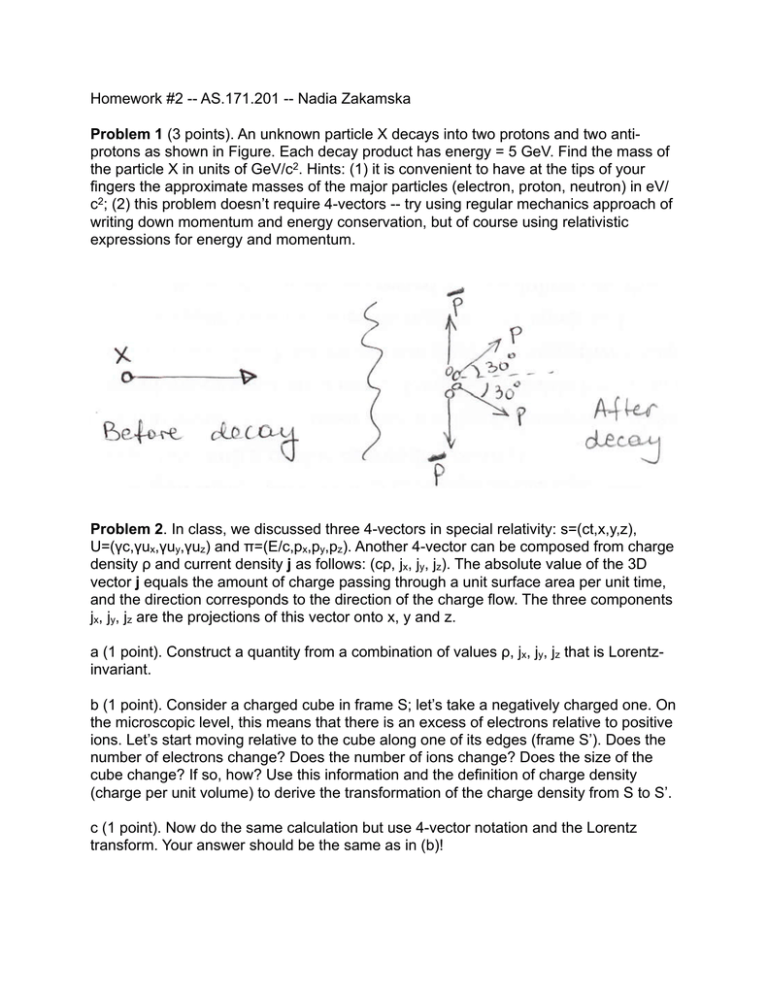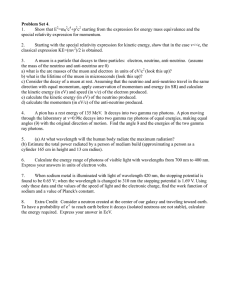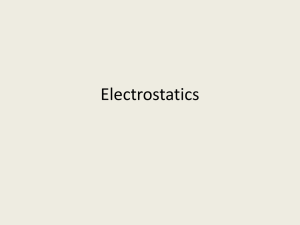Homework #2 -- AS.171.201 -- Nadia Zakamska Problem 1 (3 points
advertisement

Homework #2 -- AS.171.201 -- Nadia Zakamska Problem 1 (3 points). An unknown particle X decays into two protons and two antiprotons as shown in Figure. Each decay product has energy = 5 GeV. Find the mass of the particle X in units of GeV/c2. Hints: (1) it is convenient to have at the tips of your fingers the approximate masses of the major particles (electron, proton, neutron) in eV/ c2; (2) this problem doesn’t require 4-vectors -- try using regular mechanics approach of writing down momentum and energy conservation, but of course using relativistic expressions for energy and momentum. Problem 2. In class, we discussed three 4-vectors in special relativity: s=(ct,x,y,z), U=(γc,γux,γuy,γuz) and π=(E/c,px,py,pz). Another 4-vector can be composed from charge density ρ and current density j as follows: (cρ, jx, jy, jz). The absolute value of the 3D vector j equals the amount of charge passing through a unit surface area per unit time, and the direction corresponds to the direction of the charge flow. The three components jx, jy, jz are the projections of this vector onto x, y and z. a (1 point). Construct a quantity from a combination of values ρ, jx, jy, jz that is Lorentzinvariant. b (1 point). Consider a charged cube in frame S; let’s take a negatively charged one. On the microscopic level, this means that there is an excess of electrons relative to positive ions. Let’s start moving relative to the cube along one of its edges (frame S’). Does the number of electrons change? Does the number of ions change? Does the size of the cube change? If so, how? Use this information and the definition of charge density (charge per unit volume) to derive the transformation of the charge density from S to S’. c (1 point). Now do the same calculation but use 4-vector notation and the Lorentz transform. Your answer should be the same as in (b)! d (2 points). Imagine you are in a reference frame in which a charged blob has ρ=2/c, jx=2, jy=2, jz=2 in some units. Determine the charge density and the three components of the current density observed by someone moving at a velocity $v = ! 3/4c along the x-direction with respect to your reference frame. Problem 3. A proton and an anti-proton traveling at 1 TeV each collide at 30 degrees. The result of the collision is a single new particle, let’s call it J-particle after JHU. The proper (rest-frame, comoving) life-time of the J-particle is 10-9 sec; after that it decays. (a - 3 points) What is the mass and the energy of the J-particle? (b - 2 points) How far will the J-particle travel from the point it was created in the proton/ anti-proton collision? Problem 4 (3 points). A charged pion (mass = 273 times the mass of the electron me) at rest decays into a neutrino (which has nearly zero mass) and a muon (mass = 207 me). Find the kinetic energy of the muon and the energy of the neutrino in eV. Hint: we haven’t considered m=0 particles in detail yet, but the only thing needed for this problem is their relationship between energy and momentum: p E = p2 c2 + m2 c4 ! pc



